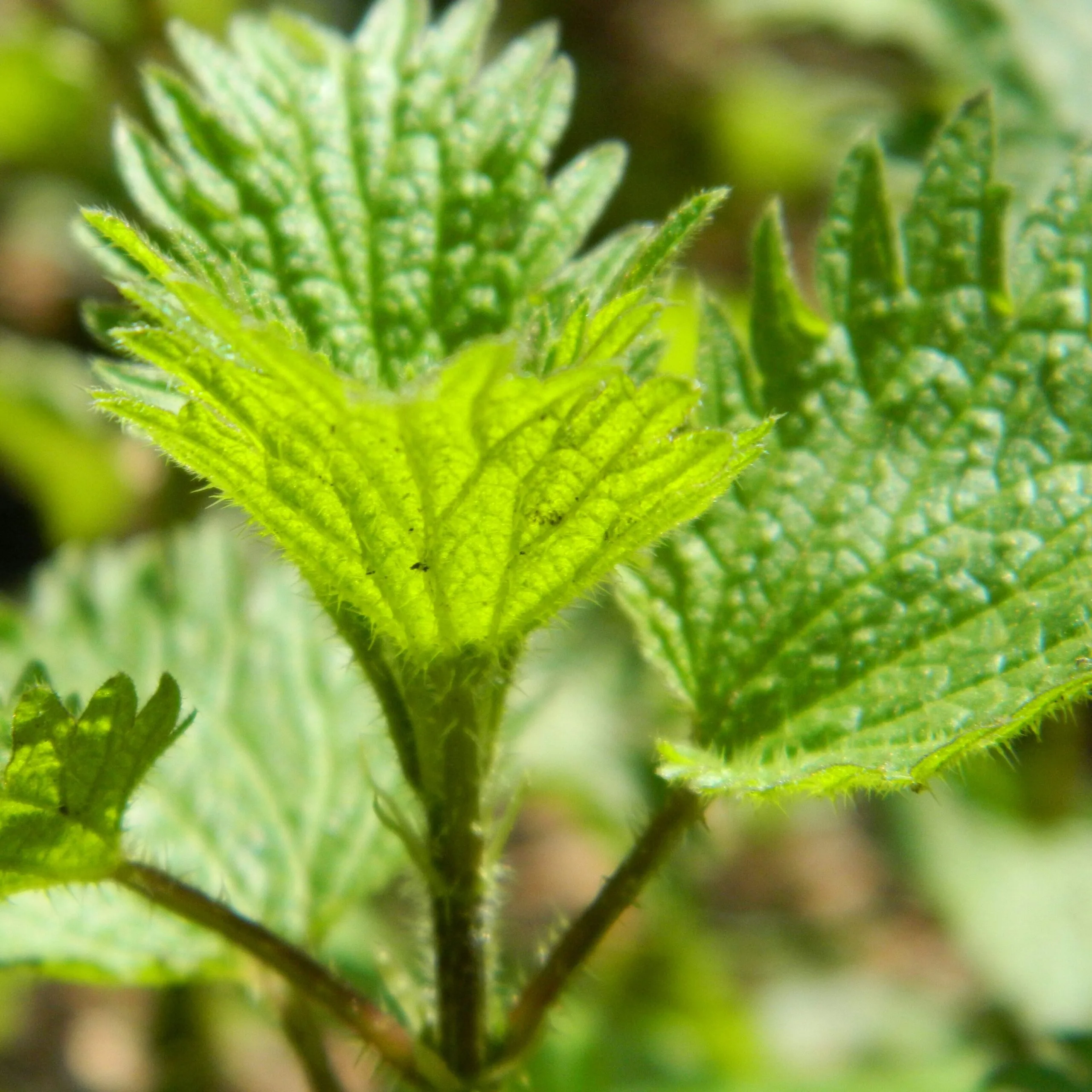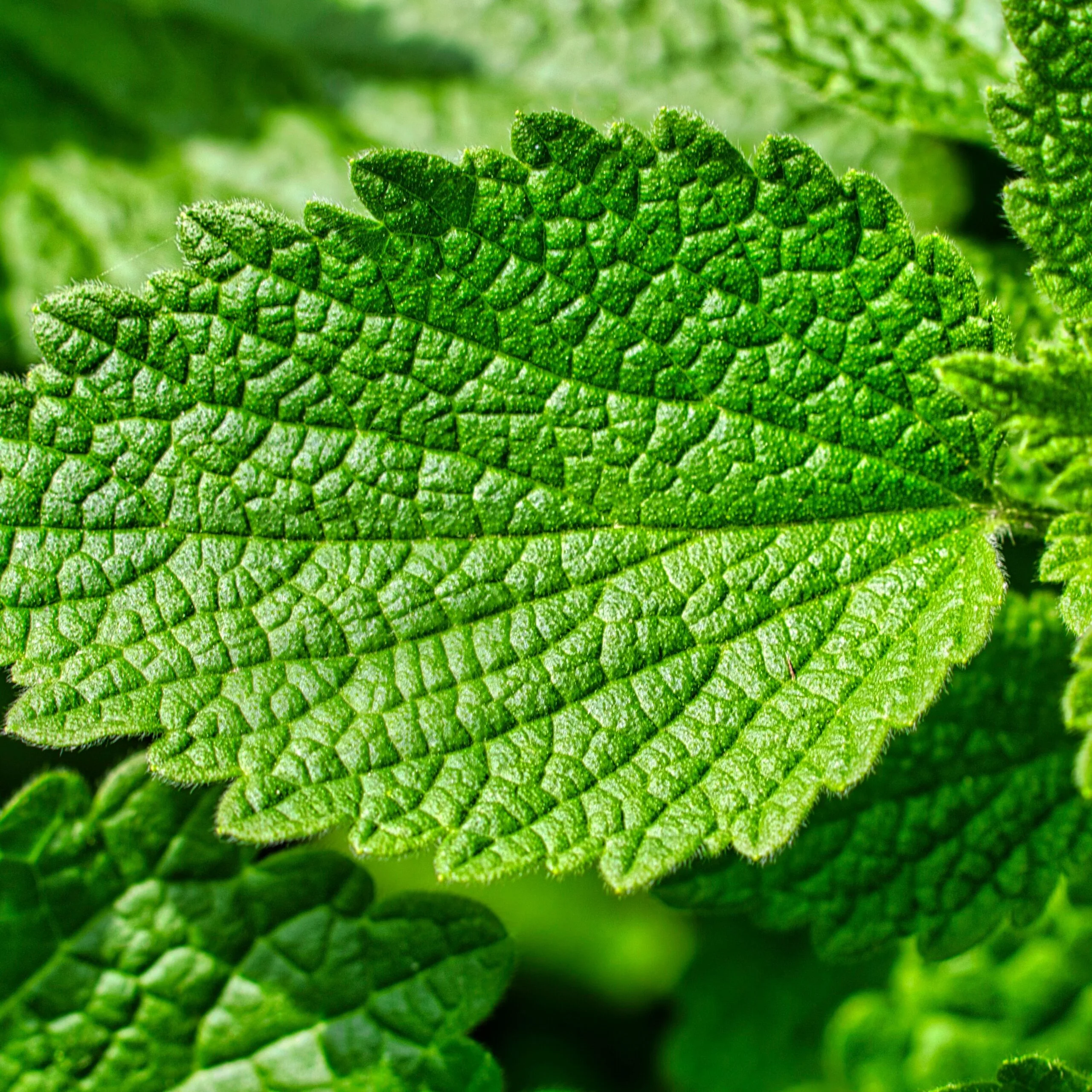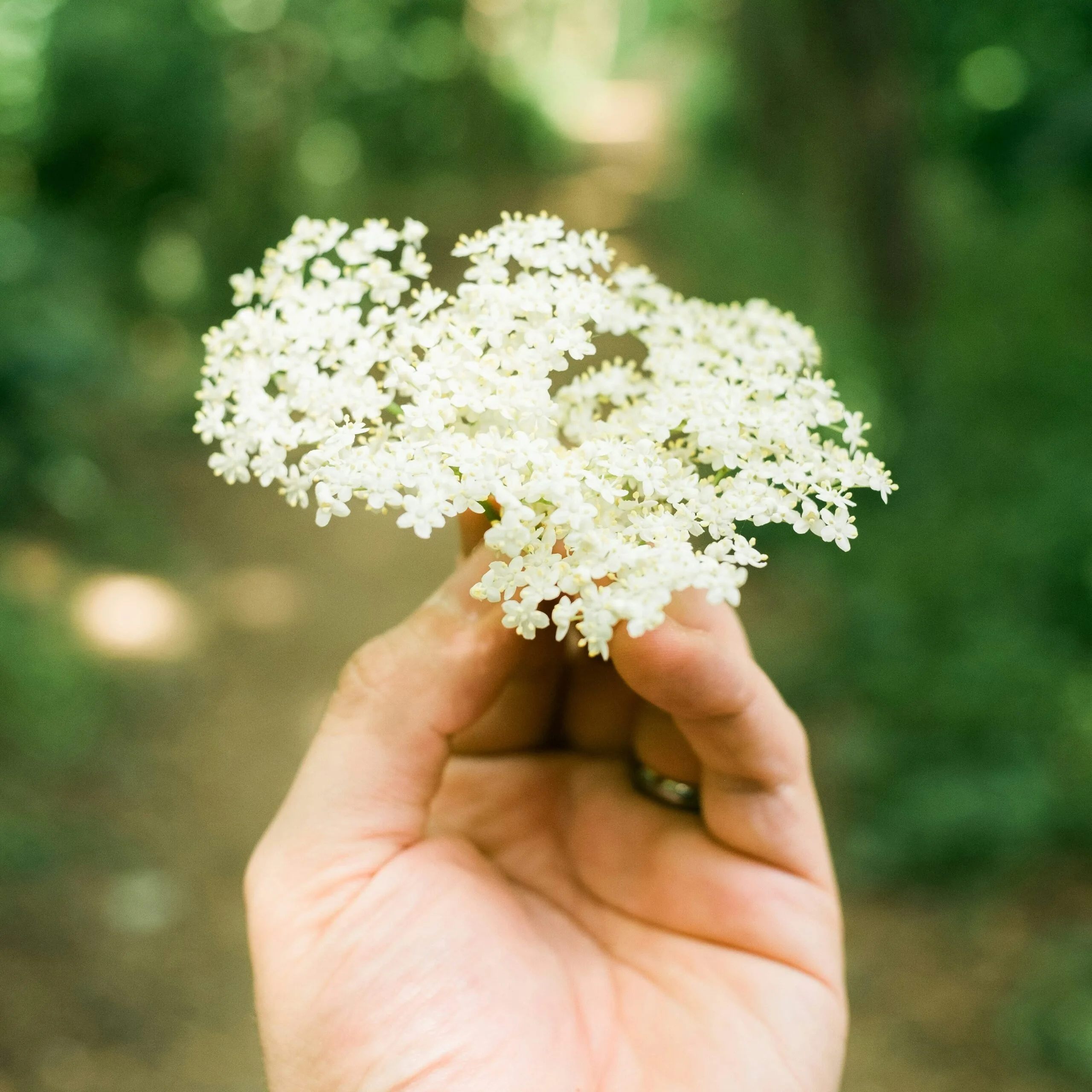
Wild garlic (Allium Ursinum)
Wild garlic, also known as ramsons, is one of the most exciting wild herbs to forage in spring. Found in damp woodlands, riverbanks, and shaded areas, it fills the air with its unmistakable garlicky aroma from March to June in Scotland. It often grows in large carpets in areas with rich, moist soil.
Some of the best places to forage include:
Urban parks and riverbanks, you can sometimes find it in city green spaces like the Water of Leith in Edinburgh.
Highland forests, Shady areas near lochs and rivers.
Lowland woodlands, particularly around Perthshire, the Borders, and Fife.
West coast glens, where the climate is damp and mild.
Wild garlic isn’t just a flavorful spring herb, it’s packed with powerful health benefits that have been recognised for centuries. Here’s why it’s worth adding to your diet:
Supports Heart Health
- Contains natural sulfur compounds (like allicin) that help lower blood pressure and improve circulation.
- Helps reduce cholesterol levels, protecting against heart disease.
- Acts as a natural blood thinner, reducing the risk of blood clots.
Boosts Immunity
- Rich in vitamin C, which strengthens the immune system.
- Has antibacterial and antiviral properties, helping fight infections and colds.
- Acts as a natural antibiotic, similar to cultivated garlic.
Supports Digestion & Gut Health
- Wild garlic is a natural prebiotic, feeding healthy gut bacteria.
- It helps with detoxification and flushing out harmful toxins.
- Aids digestion and may relieve bloating and indigestion.
Anti-Inflammatory & Antioxidant Effects
- Contains flavonoids and polyphenols, which help reduce inflammation.
- Can support conditions like arthritis, joint pain, and autoimmune disorders.
- Helps fight free radicals, slowing down ageing and protecting against chronic diseases.
Natural Detoxifier
- Supports liver function, helping to remove toxins from the body.
- Acts as a mild diuretic, helping kidney function and reducing water retention.
Since it’s so nutritious and easy to use, wild garlic is a perfect seasonal superfood!

Wild garlic is incredibly versatile—you can eat it raw or cooked, and it adds a fresh, mild garlicky flavour to many dishes. Here are some of my favourite ways to use it:
Raw Uses (Best for Fresh, Punchy Flavour)
- Salads – Chop fresh leaves and add them to mixed greens.
- Pesto – Blend with nuts, cheese, and olive oil for a delicious spread.
- Herb Butter – Mix finely chopped leaves with butter for a garlicky spread.
- Sandwiches & Wraps – Use as a fresh, herby addition instead of lettuce.
- Infused Oil – Blend with olive oil for a drizzle over pasta or roasted veg.
Cooked Uses (For Milder, Softer Flavours)
- Soups – Add to potato or nettle soup for extra depth.
- Stir-fries & Sautés – Toss into a pan with mushrooms or greens.
- Omelettes & Frittatas – Mix with eggs and cheese for a springtime dish.
- Pasta & Risotto – Stir in at the end of cooking for a garlicky boost.
- Stuffing & Bakes – Use in savoury pastries, pies, or as a stuffing for meat or mushrooms.
Baking & Fermenting
- Wild Garlic Bread – Knead chopped leaves into bread dough.
- Pickled Wild Garlic Buds – Preserve the flower buds in vinegar for a caper-like treat.
- Wild Garlic Kimchi – Ferment with cabbage and chilli for a unique twist.
nettle (Urtica Dioica)

Nettle, often seen as a pesky stinging weed, is actually one of the most nutritious and medicinally powerful wild herbs you can find in spring. Once cooked or dried, the sting disappears, leaving behind a superfood packed with vitamins and minerals.
Grows abundantly in hedgerows, woodland edges, riverbanks, and meadows. Prefers moist, nitrogen-rich soil and can often be found in gardens and roadside verges (just forage away from pollution). Best harvested in early spring (March-May) when the leaves are young and tender.
Nettle (Urtica dioica) has been valued for thousands of years as both food and medicine. Archaeological evidence suggests that as early as the Neolithic and Bronze Ages, nettle was woven into textiles and used as a nutritious wild green. In Ancient Egypt, it was recognised for its pain-relieving properties, while the Greeks and Romans used it to treat arthritis and even practised urtication—rubbing fresh nettle leaves on the skin to stimulate circulation and relieve joint pain.
Vikings consumed nettle for strength before battle, and in medieval Europe, it was a staple remedy for gout, kidney issues, and fevers. In Scotland, nettle played a significant role in Highland traditions, providing sustenance in early spring when other greens were scarce. It was commonly used in soups and broths, as well as in fabric dyes, producing a deep green colour for wool.
Folklore even suggested that hanging nettles above doorways could ward off evil spirits. Today, nettle is celebrated as a superfood, packed with vitamins, minerals, and antioxidants, and continues to be used in natural medicine for allergies, inflammation, and digestion. Its strong fibres are also making a comeback in sustainable textiles, proving that this once-feared stinging plant remains a valuable resource in both traditional and modern times.
Health Benefits of Nettle
Rich in Nutrients – High in iron, calcium, magnesium, and vitamin C, making it great for energy and bone health.
Supports digestion – It acts as a natural detoxifier and promotes gut health and liver function.
Boosts Immunity – Full of antioxidants and anti-inflammatory compounds, helping to fight infections.
Balances Allergies & Hay Fever – Natural antihistamine properties can help with seasonal allergies.
Good for Skin & Hair – Used in teas and rinses to strengthen hair and reduce dandruff.

How to Use Nettle in Cooking:
Raw:
- Nettle Tea – Steep dried nettles in hot water for a mineral-rich infusion.
- Smoothies – Blend fresh young leaves (after blanching) with fruits for a green boost.
Cooked:
- Nettle Soup – A classic way to enjoy its earthy, spinach-like taste.
- Stir-fries & Stews – Use like spinach, adding at the last minute.
- Omelettes & Pies – Mix with eggs or cheese for a rich, herby dish.
- Pasta & Gnocchi – Blanch and blend into sauces or mix into dough.
Baking & Preserving:
- Nettle Pesto – Blend with garlic, nuts, and cheese for a fresh spread.
- Fermented Nettle Tonic – A probiotic-rich drink for gut health.
- Nettle Beer – A traditional countryside brew made from young nettles.
elderflower (Sanbucus Nigra)

Elderflower (Sambucus nigra) is a fragrant and versatile wild plant that blooms in late spring to early summer, typically from May to June. Found in woodland edges, hedgerows, and along riverbanks, its creamy white flowers grow in large clusters, emitting a sweet, floral aroma. Elderflowers have a long history of use, both for culinary and medicinal purposes. In ancient times, elderflower was revered for its healing properties and was used to treat ailments like colds, flu, and inflammation. It was also considered a sacred plant in many cultures, believed to have protective powers
Elderflower (Sambucus nigra) offers a range of health benefits, making it a valuable plant both in traditional medicine and modern wellness practices. Here are some of its key health benefits:
Immune System Support
Elderflower is often used to boost the immune system. It contains antioxidants and vitamin C, which help fight off infections, reduce inflammation, and strengthen the body’s defences. Elderflower is particularly popular during the cold and flu season for its ability to ease symptoms and help the body recover more quickly.
Cold & Flu Remedy
Elderflower is known for its ability to help with respiratory issues. It acts as a natural diuretic, helping to flush out toxins from the body. It’s also beneficial for congestion and can help reduce fever, making it a go-to remedy for the common cold or flu. Elderflower helps clear mucus from the sinuses and reduces inflammation in the upper respiratory tract.
Anti-Inflammatory Properties
Elderflower has anti-inflammatory effects, which can be helpful for conditions such as arthritis and muscle pain. The plant contains compounds that reduce inflammation and swelling, easing discomfort.
Skin Health
The antioxidants and anti-inflammatory properties of elderflower make it beneficial for skin health. Elderflower extract is used in many skincare products for its ability to calm irritation, reduce redness, and help with acne. It’s also believed to help tighten the skin and improve its overall appearance.
Digestive Health
Elderflower has traditionally been used as a digestive aid. It promotes healthy digestion by soothing the stomach and intestines. It can help relieve symptoms of bloating, gas, and constipation. Elderflower also has mild laxative properties, which can help regulate bowel movements.
Antioxidant & Detoxifying Effects
Elderflower is rich in antioxidants such as flavonoids, which help fight free radicals and protect the body from oxidative stress. This makes elderflower a natural detoxifier, supporting the body’s ability to flush out toxins and promoting overall health.
Relaxation & Stress Relief
Elderflower has a calming effect, which can help reduce stress and anxiety. Drinking elderflower tea or using it in aromatherapy can promote relaxation and improve sleep quality.
How to Use Elderflower for Health
- Elderflower Tea – Steep the dried flowers to help with colds, digestion, and relaxation.
- Elderflower Syrup – This can be consumed to boost the immune system or mixed into water or drinks.
- Elderflower in Skincare – Look for products that use elderflower extract to soothe and heal the skin.
Though elderflower is generally safe for most people, it’s always important to consult a healthcare provider before using any herb for medicinal purposes, especially if you’re pregnant, breastfeeding, or have preexisting conditions.
- Elderflower syrup is a versatile ingredient that can be used in a variety of cocktails and mocktails, adding a light, aromatic sweetness. Its ability to pair well with spirits like gin, vodka, and champagne, as well as with non-alcoholic beverages, makes it a great choice for crafting refreshing drinks for any occasion.
- Flavouring Desserts: Elderflowers can be used to flavour desserts such as cakes, custards, ice cream, and jellies. Its delicate floral taste pairs well with fruit, especially berries like strawberries and raspberries.
- Fruit Compote: Elderflowers can be infused into a fruit compote for added sweetness and a floral touch, making it a great topping for yoghurt, pancakes, or waffles.
- Elderflower Jelly or Jam: Elderflower can be used to make a fragrant jelly or jam, perfect for spreading on toast, pastries, or adding to desserts.
- In some cultures, elderflowers are used to make elderflower wine, a fragrant, homemade alcoholic beverage that captures the essence of the flower. The process involves fermenting the flowers with sugar, yeast, and other ingredients like lemon or citrus.
Pingback: Spring joy Peas veloutè, wild garlic, crowdie bon-bon - L'AtelierbyChefAlberto.com